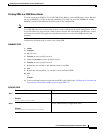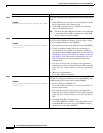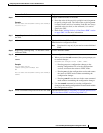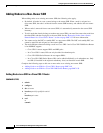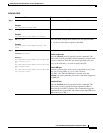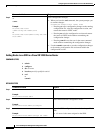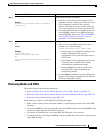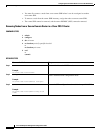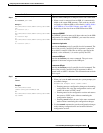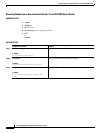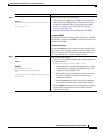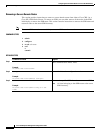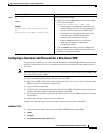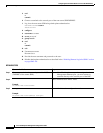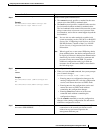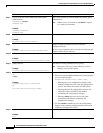
Configuring Secure Domain Routers on Cisco IOS XR Software
How to Configure Secure Domain Routers
SMC-153
Cisco IOS XR System Management Configuration Guide
Step 4
no location partially-qualified-nodeid
or
no location pair-name
Example:
RP/0/RP0/CPU0:router(admin-config-sdr:rname
2)#
no location 0/0/*
or
RP/0/RP0/CPU0:router(admin-config-sdr:rname
2)#
no location drp1
or
RP/0/RP0/CPU0:router(admin-config-sdr:rname
)#
no location 0/RP*/*
Removes a node, DRP pair, or RP pair from a non-owner SDR.
• When a node is removed from an SDR, it is automatically
added to the owner SDR inventory. This node may now be
assigned to a different SDR, as described in Adding Nodes
to an SDR in a Cisco CRS-1 Router, page SMC-148.
• Removing all the slots from an SDR deletes that SDR.
To remove a DSDRSC
The DSDRSC cannot be removed if other nodes are in the SDR
configuration. To remove the DSDRSC, you must first remove
all other nodes in the SDR.
To remove a single node
Enter the no location partially-qualified-nodeid command. The
value of the partially-qualified-nodeid argument is entered in
the rack/slot/* notation. Node IDs are always specified at the
slot level, so the wildcard (*) is used to specify the CPU.
To remove a DRP pair
Enter the no location pair-name command. The pair-name
argument is the name assigned to the DRP pair.
To remove an RP pair
Enter the no location partially-qualified-nodeid command. The
value of the partially-qualified-nodeid argument for RPs is
entered in the rack/RP*/* notation. This command removes both
RPs in a pair.
Step 5
end
or
commit
Example:
RP/0/RP0/CPU0:router
(admin-config-sdr:rname2)# end
or
RP/0/RP0/CPU0:router(admin-config-sdr:rname
2)# commit
Saves configuration changes.
• When you issue the end command, the system prompts you
to commit changes:
Uncommitted changes found. Commit them?
–
Entering yes saves configuration changes to the running
configuration file, exits the configuration session, and
returns the router to EXEC mode.
–
Entering no exits the configuration session and returns
the router to EXEC mode without committing the
configuration changes.
–
Entering cancel leaves the user in the same command
mode without committing the configuration changes.
• Use the commit command to save the configuration changes
to the running configuration file and remain within the
configuration session.
Command or Action Purpose



